 |
Spit Fort
Klaipėda, Lithuania
|
|
 |
Constructed: 1865-1873
Used by: Prussia, Germany
Conflict in which it participated: Second World War, sort of
Also known as: Kopgalis Fortress,
Fort Wilhelm
|
Spit Fort, so named due to its location at the northernmost tip of the Curonian Spit, a lengthy strip of land which concludes at the city of Klaipėda, was a Prussian fortress built to protect this Baltic port with a dot over its E.
The Curonians were a fierce Baltic tribe of warrior/sailor/pirates. They fought it out and/or allied with various Viking bands, sailing up and down the Baltic pillaging things, at or around the 8th century AD. Their lands were conquered by the Livonian Order, a branch of Teutonic Knights, in 1266.
|
 |
|
|
The Livonian Order built a castle at the main Curonian city of Klaipėda in the early-mid-13th century, to solidify their hold over the region in their ongoing war against the Prussians. This castle was named Memelburg, or Memel. The city of Klaipėda has been known as Memel on and off through history, depending on whom was currently holding it.
|
|
|
The Order sued for peace in October of 1323, and the Lithuanians were somehow satisfied (perhaps they were showered with Šakotis; a Lithunanian Baroque Tree Cake) and left, but returned intermittently to reconquer Klapiėda whenever they got the urge to do so. The castle was destroyed by the Lithuanians and their allies the Samogitians, another Baltic tribe, in 1379.
|
The Order replaced their destroyed castle with a "major defensive tower" in 1393, but the Lithuanians immediately came and destroyed it. The arrival in 1409 of Ulrich von Jungingen (1360-1410), the 26th Grand Master of the Teutonic Knights, sparked another spurt of fortification at Memelburg.
Grand Master Jungingen and the Order were defeated at the Battle of Grunwald in 1410, however, whereupon Klaipėda became Lithuanian territory. French engineers were hired and from 1529 to 1559, Memelburg was honed into a state-of-the-art starfort.
This state-of-the-art starfort was destroyed by Swedish forces in 1729, as part of the ongoing 30 Years' War (1618-1648). 1757 saw the rebuilt starfort of our temporary interest devastated by the Russians, as part of the Seven Years' War (1755-1764)(23 years less cool than the 30 Years' War).
|
 |
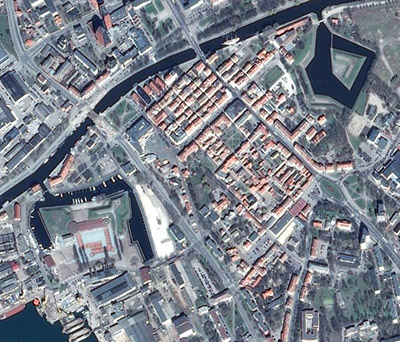 What is left of Memelburg today: The remains of a respectable starfort, and a strangely detached ravelin that seems to be distancing itself from its fort in a glacial fashion. What is left of Memelburg today: The remains of a respectable starfort, and a strangely detached ravelin that seems to be distancing itself from its fort in a glacial fashion. |
|
Memelburg was reconstructed for the last time in 1763, after which its importance faded, and the fort was left to the elements. The locals started ripping out valuable starfort articles, and nobody ventured to stop them.
Memel (as Klaipėda was then known) had become part of the Prussian Empire in 1701. For some the turbulent years of the Napoleonic Wars (1803-1815), Memel operated as Prussia's capital city. Prussian king Frederick William III (1770-1840) took up residence in Memel in 1807 and 1808, where he doubtless wished he had a kept-up starfort in which to hide.
An uneasy ally of Napoleon (1769-1821), Prussia toyed with the idea of refortifying Memel in 1812 when Boney was busy with his ill-fated Russian invasion, but caution reigned supreme in the Prussian heart, and no fortification was forthcoming.
|
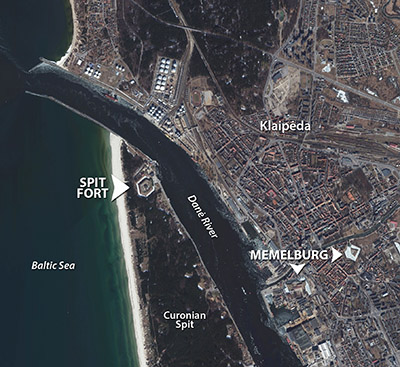 |
 |
There was some fortification action at the location of our current interest, however. Though the Order's previous experience had revealed that the spit was no place to build a full-fledged fort, a small blockhouse had been built near the tip of the spit in 1782, to keep an eye on the harbor. In 1809 and 1810, a battery of guns was added, just in case the authorities had to do something a little more substantial than observation. After 1812 these defenses were abandoned. Without some sort of solidification of the spit's marshy sandyness, it would never support a real fort, regardless of its strategic location.
Enter the German Empire. Hilariously, it was in many ways the French who were responsible for German unification. First, Napoleon abolished the Austrian-led Holy Roman Empire in 1806, which cut the bonds holding several Germanic states back. |
|
Next, Napoleon III (1808-1873) was so unwise as to goad Prussia into the Franco-Prussian War of 1871, which resulted not only in the utter destruction of France's army (and capture of Napoleon III), but also the sudden unification of all of those Germanic states into one extremely alarming and powerful Empire, smack in the middle of Europe.
|
Already the northernmost Prussian city, and one with an important port to boot, Klaipėda now found itself to be the northernmost city of the German Empire, and the beneficiary of much Imperial expenditure. A program of tree-planting had been underway on the Curonian Spit for several years, solidifying its surface and paving the way for Spit Fort, ground for which was broken in 1865.
Spit Fort is a polygonal fort with three caponieres, which mimicked much of the function of a starfort's bastions. Though notionally completed by 1873, the fort underwent a series of modernizations until 1890.
|
 |
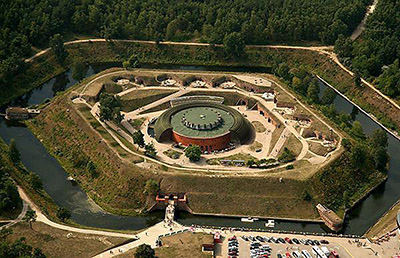 Spit Fort: Nothing to spit at. |
|
In its final form, Spit Fort was armed with 80mm Toliašaudžiais Guns (whatever those are, but they sure sound impressive, what with all those letters I can't pronounce), had its own small dedicated port, and was connected to the mainland by telegraph.
|
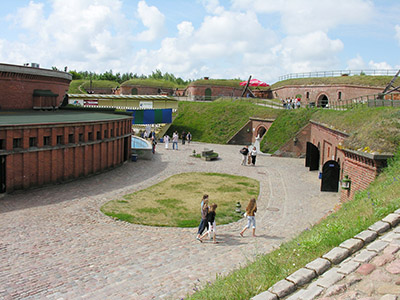
Spit Fort's courtyard, frequented by visitors to the Lithuania Maritime Museum. |
 |
Unfortunately, no fort, regardless of its strategic siting and modern armament, can defend itself against peace. In 1897 Spit Fort was declared to be unnecessary, and handed over to the civilian government. Sigh.
The end of the First World War (1914-1918) was the end of Klaipėda's association with Germany. The Klaipėda Region was made a protectorate of the Entente States (Britain, France, Italy and someplace called "Japan"), with the French acting as provisional administrators.
Lithuania staged the Klaipėda Revolt in January of 1923, taking possession of the city from the French, who only offered "limited resistance." Likely by dropping their Lebel rifles and raising their hands. |
|
Nazi Germany very much wanted Klaipėda back in its fold, and bullied its way into repossession of the city in March of 1939. Adolf Hitler (1889-1945) himself came to Klaipėda and addressed its lucky townsfolk not long before invading Poland and sparking off the Second World War (1939-1945). The Nazis occupied the city through the war, installing some antiaircraft guns in Spit Fort. When defeat became imminent, the Nazis made a halfhearted attempt to blow our fort up before departing, but were (mostly) unsuccessful.
In January of 1945, the city was "joyously liberated" by the Red Army. Always on the lookout for a decent ice-free port, the Soviet Union was more than happy to relieve Lithuania of its Klaipėda-owning burdens. The Curonian Spit was closed to the public as a border zone. The Soviet Union built Klaipėda into its biggest European piscatorial (related to fishing) base, building a huge shipyard, dockyards and a fishing port: Klaipėda's population doubled between 1945 and 1959.
|
Spit Fort had been used by some Soviet agencies through this period, and from 1972 to 1979 it was cleaned up (lots of explosives were removed) and rebuilt. In 1979 it was opened to the public as the Klaipėda Maritime Museum and Aquarium.
Lithuania declared its independence from the Soviet Union on March 11, 1990: It was the first Soviet republic to do so. Thank goodness, said Spit Fort, and renamed itself the Lithuanian Maritime Museum.
The museum holds over 60,000 items, nearly 1,000 of which are animals (surely giraffes, mountain lions and such).
|
 |
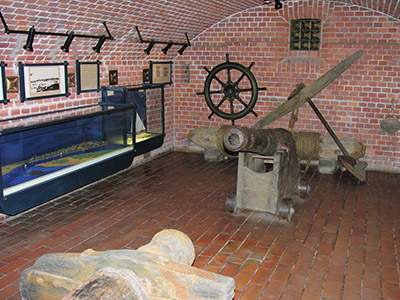 An excellent use for a casemate. |
|
Visitors to the museum can also explore Spit Fort's restored caponnieres, sally port, casemates and gun positions, whose guns have been replaced, most effectively, with anchors.
|
|
|
|
|
 |




